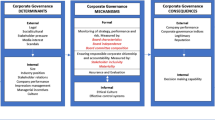Abstract
This study examines empirically the effect of managerial ownership on firms' disclosures. Agency theory predicts that investors' information requirements increase with the agency costs of the firm. Managerial ownership mitigates agency costs and therefore should reduce investors' information needs. This study tests the hypothesis that firms with lower levels of managerial ownership provide more extensive disclosures by examining analysts' ratings of firms' disclosures. In contrast to the proxies used in prior studies that test this relationship, such as the earnings-return correlation and management earnings forecasts, these ratings provide a more direct measure of firms' overall disclosure practices.
I find that the relationship between managerial holdings and disclosures depends on the type of disclosure. Consistent with the hypothesis of this study, firms with lower levels of managerial ownership are more likely to receive higher ratings for the disclosures provided in their annual and quarterly reports, even after controlling for size, performance, volatility of returns, the frequency of securities offerings and proprietary costs. The more informal and flexible aspects of disclosures, however, as measured by the investor relations rating, are not influenced by the level of managerial ownership. These results are consistent with prior research that predicts that firms lower their costs of capital by signaling a commitment to maintain a more open disclosure policy. Because annual and quarterly reports are less flexible, and therefore less likely to change, they may represent a more credible commitment to provide more informative disclosures.
Similar content being viewed by others
References
Amihud, Y. and H. Mendelson, “Asset Pricing and the Bid-Ask Spread.” Journal of Financial Economics 17, December, 223–249, (1986).
Benston, George. J., “The Benefits and Costs to Managers of Voluntary Accounting Disclosure.” Contemporary Accounting Research 3, 35–44, (1986).
Botosan, Christine A., “Disclosure Level and the Cost of Equity Capital.” The Accounting Review 72, 323–350, (1997).
Clarkson, P.M., G.D. Richardson, and J.L. Kao, “The Voluntary Inclusion of Forecasts in the MD&A Section of Annual Reports.” Contemporary Accounting Research 11, 423–461, (1994).
Darrough, M. and N. Stoughton, “Financial Disclosure Policy in an Entry Game.” Journal of Accounting and Economics, January 12, 219–243, (1990).
Diamond, D.W., “Optimal Release of Information by the Firm.” The Journal of Finance 40, September, 1071–1094, (1985).
Fishman, M. and K. Hagerty, “Disclosure Decisions by Firms and the Competition for Price Efficiency.” The Journal of Finance 44, July, 633–646, (1989).
Frankel, R., M. McNichols, and G.P. Wilson, “Discretionary Disclosures and External Financing.” The Accounting Review 70, January, 135–150, (1995).
Glosten, L. and P. Milgrom, “Bid, Ask and Transaction Prices in a Specialist Market with Heterogeneously Informed Traders.” Journal of Financial Economics 14, March, 71–100, (1985).
Jensen, M., and W. Meckling, “Theory of the Firm: Managerial Behavior, Agency Costs and Ownership Structure.” Journal of Financial Economics 3, 305–360, (1976).
Lang, M. and R. Lundholm, “Cross-sectional Determinants of Analyst Ratings of Corporate Disclosures.” Journal of Accounting Research 31, 246–271, (1993).
Noe, C., Management Earnings Forecasts and Insider Trading Activity, University of Rochester, 1995.
Opler, T. and S. Titman, “Financial Distress and Corporate Performance.” The Journal of Finance 49, September, 1015–1040, (1994).
Ruland, W., S. Tung, and N.E. George, “Factors Associated with the Disclosure of Managers Forecasts.” The Accounting Review 65, July, 710–724, (1990).
Sengupta, P., “Corporate Disclosure Quality and the Cost of Debt.” The Accounting Review 73, October, 459–474, (1998).
Verrecchia, R., “Discretionary Disclosure.” Journal of Accounting and Economics, 5 December, 179–194, (1983).
Warfield, T., J. Wild, and K. Wild, “Managerial Ownership, Accounting Choices, and Informativeness of Earnings.” Journal of Accounting and Economics 20, 61–91, (1995).
Welker, M., “Disclosure Policy, Information Asymmetry and Liquidity in Equity Markets.” Contemporary Accounting Research 11, 801–827, (1996).
White, H., “A Heteroskedasticity-Consistent Covariance Matrix Estimator and a Direct Test for Heteroskedasticity.” Econometrica 48, 817–838, (1980).
Author information
Authors and Affiliations
Rights and permissions
About this article
Cite this article
Gelb, D.S. Managerial Ownership and Accounting Disclosures: An Empirical Study. Review of Quantitative Finance and Accounting 15, 169–185 (2000). https://doi.org/10.1023/A:1008321230900
Issue Date:
DOI: https://doi.org/10.1023/A:1008321230900



